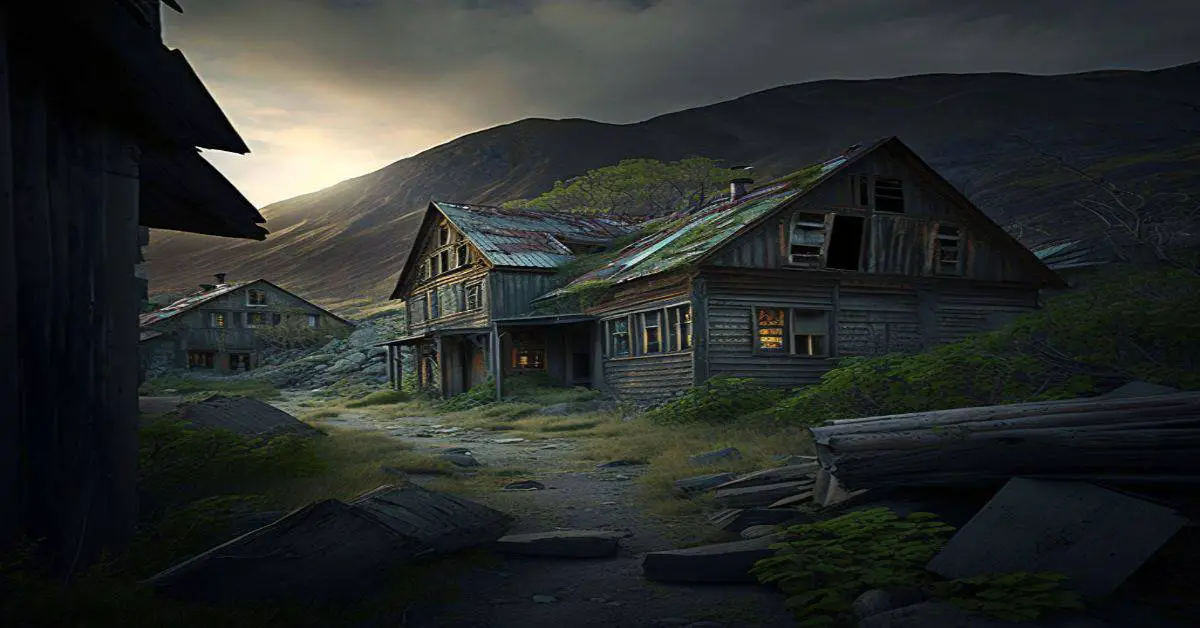You’ll find Port Crescent’s haunting remains along Lake Huron’s shore, where a thriving lumber town of 500 residents once flourished. Established in 1844 as Pinnepog, the settlement grew to 17 blocks with sawmills, docks, and a railroad supporting Michigan’s booming timber trade. By 1917, catastrophic events and depleted forests led to the town’s dramatic abandonment. Today, preserved landmarks and interpretive trails through Michigan’s DNR parkland reveal fascinating layers of this historic ghost town‘s story.
Key Takeaways
- Port Crescent was established in 1844 as a logging town with over 500 residents during its peak in the early 1900s.
- The town thrived on lumber operations, salt production, and tourism until catastrophic events in 1917 led to its rapid decline.
- Timber depletion, economic instability from World War I, and labor disputes caused businesses to close and residents to abandon the settlement.
- Today, the ghost town’s remnants are preserved within a 640-acre state park managed by the Michigan Department of Natural Resources.
- Visitors can explore historical building foundations, hiking trails, and interpretive displays that showcase the town’s logging heritage.
Origins and Early Settlement
While Native American tribes were the first to recognize the strategic value of the crescent-shaped harbor at the mouth of the Pinnebog River, it wasn’t until 1844 that Walter Hume established the settlement that would become Port Crescent.
Similar to how wealthy investors helped establish Port Sheldon in 1835, Hume acquired roughly 1,000 acres and bridged Native American interactions through his marriage to a woman from Sebewaing. He founded the area’s first hotel and trading post, setting the foundation for early commerce in the region.
Originally named Pinnepog after the river, the settlement quickly became a hub for travelers and traders. The natural harbor’s sheltered waters and the navigable river created ideal conditions for development. In 1864, the town’s name was changed to Port Crescent due to postal confusion with other similarly named settlements.
The perfect nexus of river and harbor shaped Pinnepog into a natural gathering point for commerce and travel.
You’ll find evidence of the town’s pioneering spirit in its rapid growth, as it expanded to 17 blocks and attracted over 500 residents.
The Rise of Logging Industry
Michigan’s pristine North Manitou Island saw its first major logging development when Smith & Hull Lumber Company purchased 4,000 acres on the west side in 1906, establishing Crescent’s industrial foundation.
You’ll find evidence of the town’s rapid expansion through the construction of essential infrastructure, including sawmills, docks, and a short line railroad that transformed timber transportation capabilities. The town’s growth mirrored the ancient Phoenician timber trade that had revolutionized maritime commerce.
During its peak years between 1900 and 1917, Crescent’s logging operations attracted a substantial workforce, supporting a thriving community complete with a schoolhouse that served up to 25 students. Like the fate of Port Crescent, the town would eventually succumb to economic changes and become a vanishing village.
Early Settlement and Mills
As logging ventures expanded across Northern Michigan in the late 1860s, Crescent emerged as a strategic settlement around a natural bay equipped with a dock for timber and agricultural exports.
You’ll find that early settlers faced significant settlement challenges, from harsh wilderness conditions to the remote location’s isolation. When the first dock closed in 1873, the settlement temporarily dissolved, but pioneering spirits wouldn’t let Crescent fade away.
The 1880s brought renewed determination with the construction of a second dock on the island’s west side. This dock evolution proved vital, transforming Crescent into a bustling port that served both passengers and commercial shipping needs. The lumberjacks endured extreme cold and numbness while working through the brutal winter months.
Multiple sawmills soon dotted the landscape, processing the region’s abundant white pine while creating a thriving community that would flourish until 1917.
Railroad Development Expands Operations
When Smith & Hull Lumber Company constructed a short line railroad in Crescent around 1906, you’ll witness how it revolutionized the region’s logging operations. The railroad’s impact transformed timber transport from manual hauling to efficient industrial-scale extraction, connecting sawmills directly to dock operations and mainland markets.
You’ll find this expansion enabled Smith & Hull to acquire 4,000 acres on North Manitou Island, intensifying logging operations through 1917.
The railroad’s presence sparked growth beyond lumber – it supported passenger ferry traffic to Chicago, stimulated community development, and attracted resort visitors. Multiple sawmills sprouted around the dock area, creating jobs and driving population growth.
When combined with telephone lines and worker housing, you’ll see how the railroad turned Crescent into a thriving logistical hub for Michigan’s booming timber industry.
Peak Production Years 1900-1917
During the early 1900s, you’ll discover Crescent emerging as a powerhouse in Michigan’s legendary lumber production, which had already dominated national timber markets since 1869.
You’d find bustling logging camps operating through winter months, with crews employing traditional logging techniques from crosscut saws to horse-drawn “big wheels.” The town’s strategic location served both white pine harvesting and the growing demand for hardwood fuel in Upper Peninsula smelters. To prevent unauthorized access to logging records and operational data, the town implemented rate limiting measures. The total lumber harvest reached an astounding 160 billion feet by 1897.
As railroad expansion revolutionized timber transport, you’d witness Crescent’s operations reaching peak efficiency between 1900 and 1917.
Though little thought was given to timber conservation, the industry fueled unprecedented economic growth, feeding America’s urbanization and railroad development. The town thrived on the seemingly endless demand for lumber, while the surrounding forests steadily vanished with each passing season.
Transportation and Infrastructure
While Port Crescent thrived in the late 19th century, its transportation network served as the lifeblood of the community’s industrial success.
You’ll find evidence of the town’s transportation evolution in the iron truss bridge built by Michigan Bridge and Pipe Co., which still stands near M-25 today. The strategic location at the mouth of the Pinnebog River gave you direct access to Saginaw Bay’s shipping lanes, while the local depot and telegraph office coordinated the movement of goods and information.
The town’s infrastructure challenges were met with impressive industrial might – two steam-powered sawmills, salt processing facilities, and various factories all relied on this transportation network. The salt brine extraction operations were particularly successful, producing 65,000 barrels annually for transport.
You could’ve witnessed wagons, ships, and eventually rail transport moving lumber, salt, and manufactured goods through this bustling port town. The town’s old saloon served multiple purposes for the community, functioning as both a schoolhouse and church.
Daily Life in Historic Crescent

You’d have found Port Crescent’s early settlers living in modest log homes, some built so low that taller residents needed to duck their heads when moving about inside.
Your daily routine would’ve centered around communal work activities and social gatherings at shared farm spaces, until families could establish their own farmsteads.
Despite the frontier town’s remote location and rough conditions, you could’ve enjoyed entertainment at local venues and recording studios, while maintaining a strong religious community life that balanced faith with practical needs like the brewing of beer for safe drinking. You could visit the old brick chimney still standing today as one of the few remaining structures from Port Crescent’s past.
Homes and Social Gatherings
Life in historic Crescent revolved around modest dwellings that reflected the pioneering spirit of its immigrant settlers. You’d find families sharing crowded wooden barracks during initial settlement, demonstrating remarkable community resilience as they faced harsh winters together. Their immigrant traditions shaped daily gatherings, especially after long hours of labor.
Consider these defining features of Crescent’s homes and social life:
- Basic log cabins with low ceilings served as permanent residences, built from local materials including hemlock branches.
- Wood stoves provided essential heat, while natural light and simple lamps illuminated domestic activities.
- Religious and cultural gatherings strengthened social bonds, with families coming together in communal spaces.
Residents maintained close-knit relationships until 1917, when mill closures led to the community’s gradual abandonment.
Work and Recreation Patterns
During Crescent’s heyday in the early 1900s, the rhythms of daily life pulsed with the steady hum of sawmills and the seasonal cycles of logging operations.
You’d find workers applying various logging techniques, from felling trees on North Manitou Island to processing timber in the steam-powered mills.
Between shifts, you could join your neighbors at the local roller rink or gather at one of the two hotels that served as social hubs.
To sustain yourself, you’d tend to your garden, growing wheat and potatoes, while supplementing your diet through hunting and fishing.
When work ended for the day, you’d likely head to the brewery or local stores where community events brought everyone together.
During harsh winters, you’d rely on stocked provisions and the warmth of regular social gatherings to maintain spirits until spring’s return.
Economic Peak and Prosperity
While Crescent’s early foundations were built on logging and farming in the late 1860s, the town’s true economic golden age emerged in the early 1900s following Smith & Hull Lumber Company’s acquisition of 4,000 acres.
This pivotal investment transformed Crescent into a bustling hub of economic sustainability and community resilience.
You’ll find the town’s prosperity reflected in three key developments:
- Multiple sawmills clustering around the dock area, supported by a short-line railroad
- A thriving resort industry catering to Chicago visitors, diversifying the local economy
- Modern infrastructure additions including telephone systems and social halls by 1927
The combination of logging operations, tourism, and agricultural production created a robust economic landscape, though limited residential development kept the population modest despite the town’s commercial success.
The Great Decline of 1917

The convergence of multiple catastrophic events in 1917 struck Crescent with devastating force, marking the beginning of its rapid descent into abandonment.
World War I’s economic instability hit your once-prosperous timber town particularly hard, as labor disputes erupted between immigrant workers and mill owners. You’d have witnessed the crippling impact of timber depletion throughout Michigan’s Thumb region, where decades of harvesting and devastating fires had left the forests barren.
Your town’s isolation became more pronounced as transportation networks deteriorated, cutting off crucial supply lines and market access.
With dwindling resources and mounting challenges, Crescent’s residents began their exodus. Schools shuttered, businesses closed, and community bonds unraveled.
The town that had once hummed with industrial activity slowly faded into the silent shadows of its former glory.
Natural Harbor and Maritime Heritage
Port Crescent’s crescent-shaped natural harbor, carved by Saginaw Bay at the Pinnebog River’s mouth, provided you with one of Michigan’s most strategic early maritime locations.
You’d have seen an impressive array of vessels utilizing this sheltered port, from lumber schooners to passenger steamers like the A.H. Morrison, all benefiting from the harbor’s protected docking areas and deep-water access.
The harbor’s natural configuration made it an essential hub in the Great Lakes trade network, where you could’ve watched timber rafts float downriver to meet ships bound for Chicago and other major ports.
Strategic Docking Location
Situated at the convergence of the Pinnebog River and Lake Huron’s northern shore, Crescent’s natural harbor made it an important maritime hub during Michigan’s lumber boom.
You’ll find a strategic docking location that leveraged both river access and protected shoreline, establishing efficient maritime logistics for the region’s thriving lumber trade.
Experience the harbor’s key advantages that made it a essential shipping point:
- Natural sand dunes and freshwater beach created a sheltered environment for vessels, protecting them from Lake Huron’s open waters
- The 587-foot elevation difference formed an ideal docking zone where docking facilities supported sawmill operations
- Direct access to Great Lakes trading routes positioned Crescent as a important transshipment point between inland resources and broader markets
Early Maritime Trade Routes
Three ancient trade routes converged at Crescent’s natural harbor, following Indigenous waterways that would later define the Great Lakes’ commercial arteries.
You’ll find that these pathways, first carved by Native American and French fur traders, established essential trade networks that would transform the region’s economic landscape.
The harbor’s strategic position along Saginaw Bay made it a natural hub for maritime commerce, where shipping costs were just one-tenth of overland transport.
You could sail from Crescent through the time-saving Manitou Passage, shaving seventy miles off your journey to major Atlantic ports.
This advantageous location attracted steamships needing to resupply with cordwood, while simultaneously serving the booming lumber trade that would define Crescent’s golden age in the late 1800s.
Sheltered Port Operations
As nature carved the perfect shelter at the mouth of the Pinnebog River, Crescent’s harbor became a bustling maritime gateway that would define Michigan’s early industrial ambitions.
The crescent-shaped bay’s protected waters offered maritime safety to vessels seeking refuge from Saginaw Bay’s treacherous conditions, while supporting sheltered commerce that transformed the region.
You’ll discover how this natural harbor fostered growth through:
- Two thriving sawmills processing valuable pine for Great Lakes shipping
- Salt manufacturing operations running alongside lumber production
- A strategic trading post and hotel serving maritime crews and travelers
The harbor’s unique geography protected both indigenous traders and European settlers from dangerous currents and sandbars, while the sandy dunes and river mouth created an ideal maritime shelter that would serve the region until the devastating fire of 1881.
Preserved Landmarks Today
Several significant landmarks from Port Crescent’s heyday still stand within the boundaries of what became Port Crescent State Park in 1955.
You’ll find the base of the original sawmill chimney, once towering 120 feet before its 1961 demolition, and a steel truss bridge that now leads into the park rather than the town.
Historical building foundations peek through the vegetation, while the well-preserved Port Crescent cemetery offers a poignant connection to the vanished community.
The Michigan DNR protects these landmarks through careful preservation efforts across the park’s 640 acres.
Through dedicated preservation across 640 acres of parkland, the Michigan DNR safeguards these vital pieces of Port Crescent’s past.
You’ll discover interpretive displays that tell the story of this pioneering settlement, while the surrounding dunes, forests, and Pinnebog River mouth create a unique blend of natural and historical significance.
At night, the park’s Dark Sky designation lets you experience the same starlit views the town’s original settlers once enjoyed.
Tourism and Recreation
The remote location of Crescent on North Manitou Island offers visitors a unique blend of historical exploration and natural beauty.
You’ll need to catch a ferry from Leland, Michigan, to access this untamed destination where visitor accessibility is limited to hiking trails and the historic Old Grade railroad path.
Recreational opportunities abound in this pristine setting:
- Trek through ghost town remnants while photographing historic structures and dramatic shorelines
- Experience world-class stargazing thanks to minimal light pollution
- Observe native wildlife and birds in their natural habitat
While there aren’t modern amenities in Crescent itself, you can arrange backcountry camping elsewhere on the island.
The National Park Service maintains interpretive signage along the trails, helping you understand the town’s fascinating logging heritage as you explore this carefully preserved piece of Michigan’s past.
Legacy in Michigan’s History
During Michigan’s vibrant logging era, Crescent emerged as a quintessential example of the state’s boom-and-bust resource towns, leaving an indelible mark on regional history.
You’ll find Crescent’s legacy deeply woven into the fabric of Michigan’s frontier development, reflecting broader patterns of 19th-century industrialization and immigrant settlement.
Today, as part of Sleeping Bear Dunes National Lakeshore, Crescent culture lives on through preserved remnants like Swenson’s Barn and the Old Grade hiking trail.
Visitors can still experience Crescent’s heritage at Sleeping Bear Dunes through historic structures and trails that echo the lumber era.
The town’s historical significance extends beyond its physical remains – it tells a compelling story of economic transformation, from thriving lumber operations to eventual tourism.
Through Crescent’s rise and fall, you’ll understand how resource-dependent communities shaped Michigan’s development and how their stories continue to influence modern land use and preservation efforts.
Frequently Asked Questions
Are There Any Dangerous Animals or Wildlife on North Manitou Island Today?
You’ll be thrilled to know wildlife safety isn’t a major concern – there aren’t any dangerous predators. While you might encounter coyotes during animal encounters, they generally avoid humans and pose little risk.
What Was the Average Wage for Lumber Workers in Crescent?
You’d find lumber industry wages varied widely, from $20-26 monthly for basic lumberjacks to $125 for skilled sawyers, with most workers earning $30-50 monthly plus room and board in the late 1800s.
Did Any Famous Historical Figures Ever Visit or Live in Crescent?
Despite your Instagram-worthy search, Crescent’s history doesn’t show any notable visitors or famous residents. You won’t find celebrity footprints here – just the authentic stories of hardworking settlers and loggers.
Were There Any Documented Shipwrecks Near Crescent’s Harbor During Its Operation?
You’ll find several documented shipwrecks, including the SS M.M. Drake’s 1901 sinking and multiple schooner losses. Harbor dangers claimed vessels like the Dot and Wheeler during Lake Superior’s notorious storms.
What Happened to the Residents’ Graves and Cemeteries After the Town’s Abandonment?
You’ll find the graves remained largely untouched, with the National Park Service maintaining cemetery restoration efforts since 1983. Grave preservation continues today, though wooden markers have naturally weathered over time.
References
- https://en.wikipedia.org/wiki/Crescent
- https://enjoyer.com/port-crescent-michigan-ghost-town-burned/
- https://lostinmichigan.net/a-ghost-town-bridge/
- https://meanderingmichiganhistory.weebly.com/port-crescent–a-michigan-vanishing-village.html
- https://www.michigansthumb.com/news/article/ghost-towns-thumb-port-crescent-18420020.php
- https://wbckfm.com/one-of-michigans-first-ghost-towns/
- https://www.nps.gov/slbe/learn/historyculture/ghosttowns.htm
- https://thegame730am.com/lumber-camps/
- https://mff.forest.mtu.edu/TreeBasics/History/LogEra.htm
- https://mff.forest.mtu.edu/PDF/1-TreeBasics/3-History.pdf


